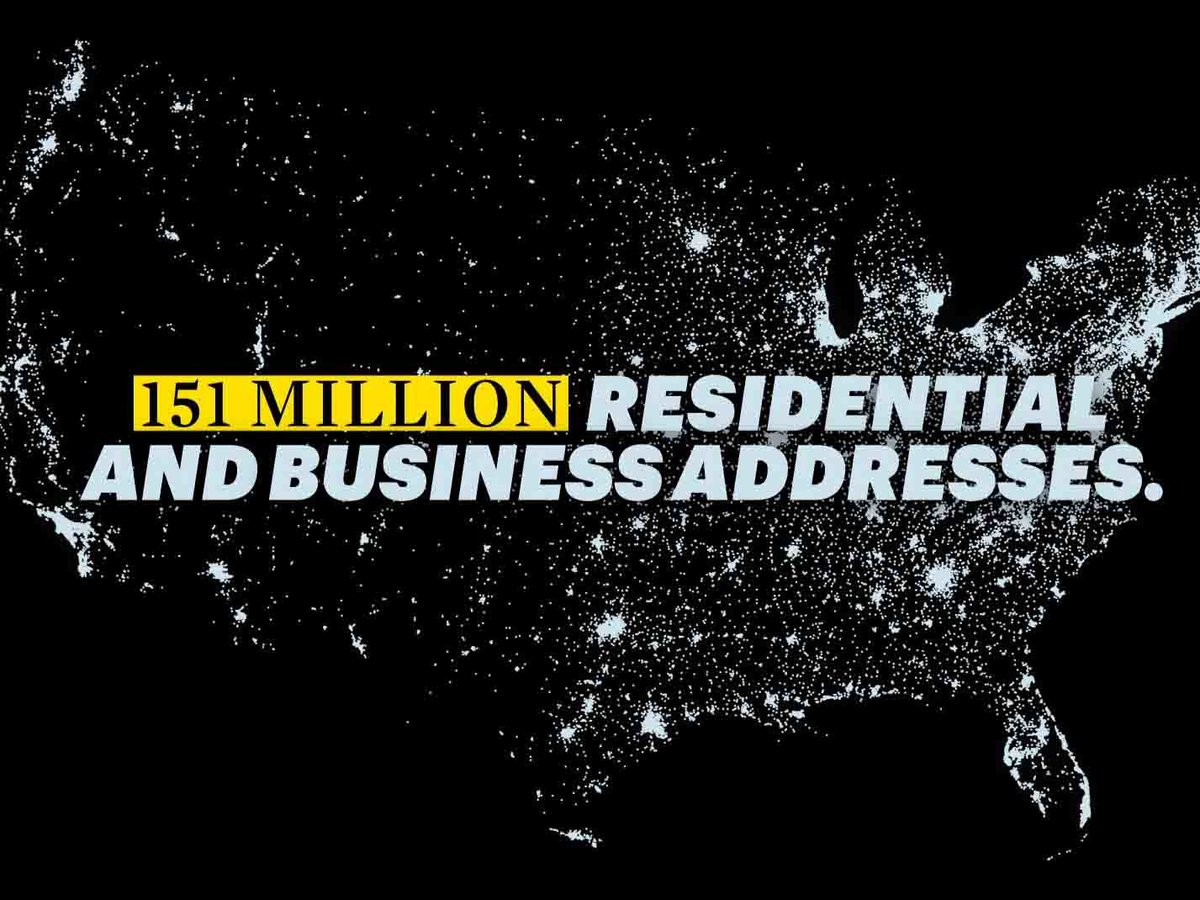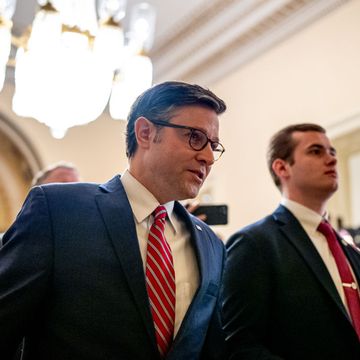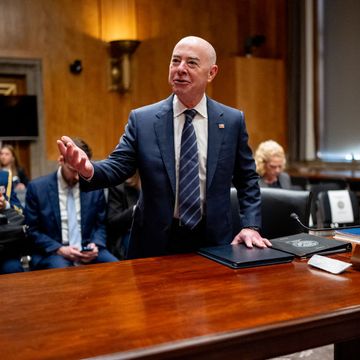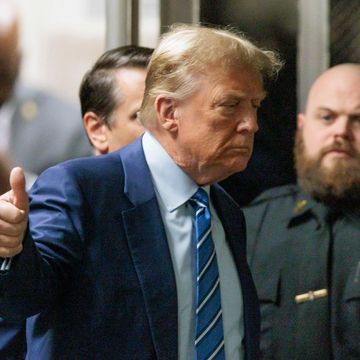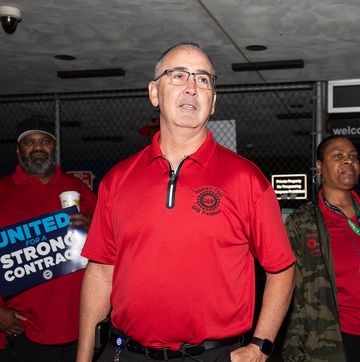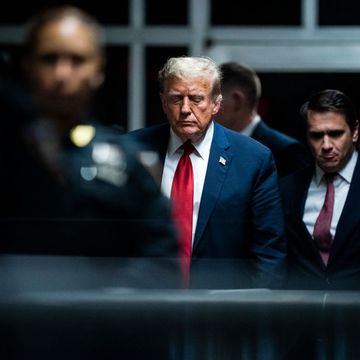PLUS: The Petition to Save the Post Office Now
AND: The American Post Office's Painted History
Published in the February 2013 issue
The letter is mailed from Gold Hill, Oregon.
The eleven hundred residents of this lingering gold-rush town, mostly mechanics and carpenters and retail clerks in other places, wake with the sun and end their day with a walk to the aluminum mailbox bolted to a post at the edge of their yard. In between, Carrie Grabenhorst heads out of town on highway 99, follows the Rogue River, and turns right on Sardine Creek Road. She turns left at a large madrone tree and heads up a quarter mile of dirt road, takes the right fork, goes past the sagging red barn to a white clapboard house with green trim, where she takes a dog biscuit from her pocket and offers it to the large golden retriever. It's a Monday, about 2:00 p.m. The dog stops barking. This is the usual peace, negotiated after thousands of visits over eighteen years.
Often Grabenhorst's elderly customers are waiting at the door, or even by the mailbox, for her right-hand-drive Jeep to edge onto the shoulder. Many of them are alone all day. Their postal carrier is that one reliable human contact, six days a week. Some are older veterans. Quite a few have limited mobility, and it isn't uncommon for her to lend a hand with an errand; she's been known to pick up milk in town and bring it along with the mail. Grabenhorst drives seventy miles a day and makes 660 deliveries. On a typical day, that might include fifty packages of medicine.
Her route is one of 227,000 throughout America. On the South Side of Chicago, carriers walk cracked sidewalks, past empty lots and overfilled projects. In the suburbs of Phoenix, mail trucks deliver to banks of mailboxes outside gated communities. In Brooklyn, they pushed their carts up sidewalks and ducked into bodegas on September 11, as they always do. Residents say they were comforted to see their postal workers still making the rounds, the government still functioning. In rural Alaska, mail comes by snowmobile and seaplane. In chaps and a cowboy hat, Charlie Chamberlain leads a train of postal mules down to the bottom of the Grand Canyon, where a tribe of Havasupai Indians lives. Wearing blue trunks and a ball cap, Mark Lipscomb delivers letters by speedboat up and down the Magnolia River in Alabama.
Want to send a letter to Talkeetna, Alaska, from New York? It will cost you fifty dollars by UPS. Grabenhorst or Lipscomb can do it for less than two quarters: the same as the cost of getting a letter from Gold Hill to Shady Cove, Oregon, twenty miles up the road. It's how the postal service works: The many short-distance deliveries down the block or across the city pay for the longer ones across the country. From the moment Benjamin Franklin was appointed the first postmaster general in 1775, the purpose of the post office has always been to bind the nation together. It was a way of unifying thirteen disparate colonies so that the abolitionist in Philadelphia had access to the same information and newspapers as the slaveholder in Augusta, Georgia.
Today the postal service has a network that stretches across America: 461 distribution centers, 32,000 post offices, and 213,000 vehicles, the largest civilian fleet in the world. Trucks carrying mail log 1.2 billion miles a year. The postal service handles almost half of the entire planet's mail. It can physically connect any American to any other American in 3.7 million square miles of territory in a few days, often overnight: a vast lattice of veins and arteries and capillaries designed to circulate the American lifeblood of commerce and information and human contact.
Grabenhorst sports a few blond streaks in her brown bangs, which curl over her forehead, perfectly framing her azure eyes and chiseled cheekbones. Rural carriers don't wear official uniforms, so today she's in shorts and an Oregon State T-shirt. Letters arrive at the post office in Gold Hill already sequenced in the order Grabenhorst will deliver them, but the "flats" — magazines, catalogs, large envelopes — and packages do not, so in the back of the post office she and her two colleagues stand at their own three-sided bank of metal slots, hundreds of them, one for each address, and merge the separate streams — a process called "throwing the mail."
As the junior carrier, Grabenhorst has the peanut route. Paula Joneikis is the senior carrier, thirty-three years on the job; she took over her route from another lifer named Bev Washburn. That's how these jobs work — when you get a route, you hold on to it, maybe even try to pass it on to someone in your family. Failing that, you take a younger colleague under your wing and share your particular wisdom: the life history of your customers, how this one is related to that one, when so-and-so got to town, when so-and-so split up. Joneikis has a lot of "silver foxes" on her route — she tries to remember who's recently had an operation, and she'll come to the door with the mail. "We're a lifeline to these people," she says.
Jake Stangel
Step 1: Mail Pickup Carrie Grabenhorst (inset) picks up a letter in Oregon bound for New York City around 2:00 p.m. Two hours later, she is back at the local post office, where she and Paula Joneikis (bottom) bundle the bins and trays of outgoing mail onto rolling carts, which are then loaded onto an eighteen-wheeler for the thirteen-mile drive to the Medford Mail Processing Center.
"All of these people are family," Grabenhorst adds. She color-codes all 660 addresses for her morning sort: a little pink flag affixed to a slot means the customer is on vacation; a yellow flag means the whole family has moved; an orange flag is for customers who don't want packages left when they aren't home; a green flag means an individual has left the family: moved out, gone to college, divorced, died.
When she gets to their driveway, she'll put the bundle into their box, her box. By law, only the postal service can put mail into a mailbox. It's a monopoly that ensures every citizen, in every square mile of the country, has the ability to receive mail and that the government can reach every citizen. No branch of government serves us so consistently, so intimately — a federal employee literally touching every house in America every day but Sunday.
In mid-November, the postmaster general, Patrick Donahoe, reported that the post office had lost $15.9 billion for the year and was operating on just a few days' cash flow, having reached its legal debt limit. He all but begged Congress to take action. Mail was down 5 percent from the year before, and wages and benefits and other worker-related costs were an unsustainable 80 percent of the postal service's $81 billion operating expenses.
But nobody wants to hear that more than 70 percent of those losses were for extraordinary budget obligations mandated by Congress, or that the postal service posted its thirteenth-straight quarter of productivity gains. In a nation obsessed with cutting budgets and government fat, there is no better target than the federal postal worker who will have her route delivering paper mail for life, and then try to pass it on to her daughter.
Eighty-five percent of America's critical infrastructure is controlled by the private sector. We let private companies fight our wars; we have 110,000 defense contractors in Afghanistan compared with 68,000 American troops. We let private companies lock up 16 percent of our federal inmates and instruct 10 percent of our students. They provide our phone service and Internet access and air travel and hospital care. Surely, many believe, private companies can deliver our mail better and faster and cheaper than the federal government.
If you work with actual pieces of mail — if you are a carrier, a handler, a clerk, but not an administrator — it is said that you "touch the mail." The postal service has more than half a million full-time workers and a hundred thousand contract employees, the vast majority of which are mail touchers. Each morning, Grabenhorst enters into a ledger she keeps at her workstation exactly how much mail she's thrown and will be delivering that day. In Washington, D.C., they count in billions of pieces, but carriers talk about mail volume in feet — the width of a mail stack laid on its edge, face to flap.
On this unremarkable Monday, she'd written 14.75 feet. She flipped the pages of the ledger back to the previous year, to the same date: 17.5 feet.
That we're sending less mail is not debatable. Nor is it debatable that the post office as we've known it for the past forty years, one built for speed and brute force in sorting and distributing an ever-surging flood of paper documents, is outdated in our digital world.
This isn't a story about whether we could live without the post office.
It's about whether we'd want to.
[continued on -->]
Great Moments in Postal History
1775: Benjamin Franklin is appointed the first postmaster general.
1811: Fast-moving steamboats replace rafts and rowboats for mail transportation.
1833: Abraham Lincoln is appointed postmaster of New Salem, Illinois, at the age of twenty-four.
1847: The first U.S. postage stamps are issued, featuring Ben Franklin on the five-cent stamp and George Washington on the ten-cent stamp.
1860: The Pony Express is contracted as a mail carrier until the transcontinental telegraph line is finished.
1933: President Roosevelt's New Deal sponsors the placement of more than a thousand public murals and sculptures in post offices to boost morale during the Great Depression.
1957: First semiautomatic sorting machine installed in Silver Spring, Maryland, doubling the sorting capabilities of clerks.
1958: Harry Winston sends the Hope Diamond to the Smithsonian Institution via first-class mail from New York City to Washington, D.C., for $2.44.
1963: ZIP codes introduced. 1970: President Nixon changes the postal service from government Cabinet department to independent federal agency.
2006: The last year the postal service turned a profit — $900 million.
In they stream from every outpost of the postal service's territory to assess the damage for themselves. State Farm's in from Bloomington, Illinois. Citi, Pacific Gas and Electric, and Crate & Barrel all made the trip, as did the publishing conglomerates, Condé Nast, Hearst, and Time Inc. The Netflix guys are mingling in the atrium near the Hallmark-greeting-card people and someone from Western States Envelope & Label. Orlando in early April is warm but not stifling.
Patrick Donahoe emerges from the wings and walks downstage at the Gaylord Convention Center. He's a stocky man with a large oval face that looks perpetually worn-down and slightly unshaven, as if he's been stuck too long in a waiting room.
"Are we old-school?!" he asks the crowd. His head is framed by short, wavy salt-and-pepper hair. Below his tired hazel eyes, he has a slight smudge of a birthmark on his left cheek, like a coffee stain he can't wipe away.
"I don't know about you, but I don't want to be old-school!" The room filled with four thousand of the postal service's best customers and suppliers is polite but largely silent.
Donahoe began his career as a twenty-year-old clerk in his hometown of Pittsburgh to pay his way through college. It was the definition of a steady job — $4.76 an hour, the same folks pushing through the glass door week after week, the same stacks of letters and money orders. After a while, you get a feel for the weight of an ounce, a calibration, somewhere in the wrist.
After college, Donahoe oversaw postal-service fleet maintenance in Pittsburgh. He viewed the network through the prism of gas prices and mileage. Several posts and a master's degree from MIT later, he moved up to the national level, overseeing human resources and then operations for the entire postal-service network. It was in D.C. that he got enmeshed in some of the postal service's biggest liabilities: the union contracts' no-layoff clauses, which limited its ability to downsize. The astounding cost of administering benefits to more than a half million workers plus retirees. While the cost of paying workers has declined 3 percent below inflation since 1972, the total cost of administering benefits to them has rocketed 448 percent. During the same time, total mail volume has nearly doubled, and the number of delivery points has exploded — more than six hundred thousand new addresses added in 2011 alone.
When Donahoe testifies on Capitol Hill, as he has done several times over the past two years, to describe just how dire the postal service's situation is — losing $25 million per day! — he talks in even, polite tones. Because there he's not telling, he's asking. Five hundred thirty-five members of Congress ultimately decide how to run the postal service: what it can charge for postage, which services it can offer, how it operates. Donahoe is the person who implements their policies, despite the postal service not being a federal agency or taking any taxpayer money; it runs solely on the postage it sells — or lately, doesn't.
Take the most contentious issue: the seventy-five years' worth of future-retiree health benefits that in 2006 a lame-duck session of Congress legislated the postal service prepay over the following ten years as part of a broad overhaul of the way the postal service operates. No other government agency must do this, and most private companies would have spread those payments over forty years. But the postal service was flush at the time, and Congress figured out that since health-care payments are counted as general government revenue, it could use them to prop up its own books. (Five-and-a-half billion dollars a year coming in from the postal service was $5.5 billion less Congress would have to cut elsewhere to remain budget-neutral, as the Bush administration was demanding.) But then the economy crashed and with it the amount of first-class mail being sent around the country. Suddenly a law designed to keep the postal service solvent in the long term began bankrupting it. Of the $15.9 billion the postal service lost last year, 70 percent — $11.1 billion — was in future health-care payments.
Jake Stangel
Step 3: Addresses Bar-Coded — An Optical Character Reader (interior shown) takes a scan of each address, which a computer then matches to the postal service's master database of 151 million addresses. Once a destination is confirmed, the envelope is bar-coded.
Today, at the National Postal Forum, Donahoe is not beseeching, he's selling. Forget finding new customers. He just wants to make sure he keeps those he already has. The big mailers before him employ 8.5 million Americans. That's almost three of every fifty American jobs. And the billions of insurance bills and catalogs and summonses these companies send every year pump $1 trillion into the economy.
In one session, a strategic business planner from the postal service asks for a show of hands from "all of those who think the postal service and industry is in a death spiral." A few honest palms dart up. The mailers want to know that Donahoe has a plan. They want to believe that Congress is listening. They want to be reassured that the post office won't abruptly fail.
Donahoe's speech is full of optimism about the potential of the post office in the digital age. He talks about QR codes that drive potential customers to Web sites from mail and an iPhone app that lets you design and send a paper postcard. He talks about growing the package business and becoming leaner, faster, and smarter as an organization. "I think that we've got a very, very strong Forum this year," Donahoe says. "You're supposed to clap!" he adds. And they do.
There's a story Donahoe tells Congress and reporters and pretty much anyone else who will listen. It's about what it was like growing up as a boy in Pittsburgh, how steel was king, the U.S. Steel Tower reaching higher than any other building in the state. There was pride in that, and in the mills, and in the middle-class jobs they produced. The steel industry built not just Pittsburgh but the entire country. The railcars and railways, the skyscrapers that made New York the capital of the world, the millions of Buicks and Pontiacs that rolled out of Detroit. Hell, with three hundred thousand men and women working twenty-four-hour shifts making ships and weapons in the 1940s, Bethlehem Steel even beat Hitler.
But there's a second half to the story — about what it was like watching the industry crumble in the seventies and eighties. First from new, cheaper steel developed in Germany and Japan, where it took just five hours to smelt a ton of steel, half the time it took in Pennsylvania. And then from waves of retiree benefits that drowned many of the companies entirely. Even after the big steelmakers began using some of the most efficient smelting methods, it was too late. In the mid-1990s, they still had four retirees drawing benefits from every worker. Unable to shoulder the burden, Bethlehem Steel declared bankruptcy in 2001. After culling its workforce down to 11,500, it still had 95,000 dependents on the books.
Donahoe talks about steel because it's a cautionary tale. It is about what happens when management waits too long to make hard but necessary changes. It's about how industries that fail to adapt die.
"I've been the postmaster general now for almost eighteen months," he says at the end of his keynote address. "They say that you never really understand and appreciate how things work until you try to change them. I think this is true. Change is not easy. It's comfortable to keep things the way they are. It's comfortable not to make tough decisions. But our future is not in today's comfort zone... Your business depends upon a postal service that can reinvent itself. So that's what we're doing: We are reinventing the postal service."
A week earlier, in March, Donahoe presented his reorganization plan to a highly skeptical Congress. The post office of the 1990s, even of the last five years — huge, capable of moving a piece of mail across millions of square miles in mere hours for a nominal fee, six days a week — cannot survive, he said. He wants to get back the $49 billion the postal service has already prepaid in health benefits, wants to manage his employees' health care. But much more, his plan calls for sizing the post office for today. That means cutting 120,000 more jobs, largely through attrition; halving the number of processing centers that relay mail across the country at often breakneck speed; and drastically scaling back the hours of thirteen thousand unprofitable local post offices. He would stop nearly all Saturday mail, and ease the rate at which first-class mail races across the country, because much of the paper we do send doesn't need to get there tomorrow or on Saturday. Give me the freedom to do that, Donahoe said, and the postal service can make a profit of $6 million per day by 2016.
His plan is to shrink the post office in order to save it.
We still live in a physical world, we are still a highly dispersed nation. Things — pieces of paper or pieces of plastic or books or clothes or toys shipped in cardboard — still need to get to places where people live and work.
The letter and other mail Carrie Grabenhorst picked up on her route is emptied into bins and secured in carts, along with packages and brightly colored sacks of express mail. By 4:30 p.m., the carts are rolled onto an eighteen-wheeler that thunders down I-5 to the Medford Mail Processing Center, a large beige warehouse with a loading dock covered by a corrugated-metal awning. Inside, there's a constant whirring, a sonic substrate of machines and people in motion.
Last year, the postal service delivered 160 billion pieces of mail. That's 508 letters, packages, and magazines for every American. Much of that was delivered in two to three days. In Medford in the early evening, men and women in T-shirts, jeans, and work gloves roll the carts of raw mail off the trucks and dump the contents into large bright-orange hampers, which they call pumpkins. A handler rolls a pumpkin onto the bright-yellow hamper dumper, which flips it over like a garbage truck, sending the mail falling like clumps of wet leaves onto a conveyer belt.
When an envelope enters the mail chain, it does so alone, but then it's mixed, lost in a sea of other letters of every description, cards meant for San Francisco burying envelopes meant for Tuscaloosa and Rochester. As the mail creeps forward, spinning wands delicately shift and topple the humps, smoothing out and thinning the stream until no letter lies across another.
Jake Stangel
Step 4: Letters Are Sorted — Warren Mee feeds the mail into a DIOSS machine. As a letter enters, a wheel flings it past a bar-code reader, which directs it down the interior path corresponding to its destination.
No matter where it's headed in the U.S., first-class mail is all priced the same: forty-five cents. Germany has a modern and efficient post office that covers a territory about the size of Georgia and Florida, but it will cost you 60 percent more to send a letter. Mail a wedding invitation from Tokyo to its suburbs and it will cost you more than twice as much as sending the same item from Seattle to Boston. Yet the 2006 law prevents the postal service from raising prices for first-class or standard mail by more than the Consumer Price Index, regardless of fuel prices, regardless of what the mail actually costs to deliver. For instance, while the price of diesel used in delivery trucks has risen 60 percent since 2009, over the same period the price of sending a letter has gone up only a penny. FedEx and UPS, meanwhile, raised rates 5.9 and 4.9 percent this year alone. Some believe this pricing ceiling was added to the law after pressure from the big mailers' lobby, magazine and catalog companies, which claimed they couldn't afford to pay more. Others point to local politics: Constituents don't like it when the price of a stamp goes up.
Onward to another belt, on which individual letters, facing up and down and resting at all angles, glide toward a grooved drum that the mail must duck beneath. Thin envelopes pass; thick or bent pieces keep trying, like salmon desperate, in this case, to slip under a waterfall. Those that don't make it are handled separately; the rest drop onto a new belt in the Advanced Facer Canceler System, forming a single-file line that streams through a biochemical detector that checks for anthrax.
The AFCS is Roger Hawkins's domain. He's bald and looks a bit like Buster Bluth from Arrested Development. He wears gloves for grip and headphones for sanity as he adjusts the flow. He looks for minor irregularities, envelopes that are too large, oddly shaped postcards that might catch in the machinery. "People are sending things through the mail they shouldn't," he says, his fingers finding the outliers as if by anticipation. "Keys, USB drives, jewelry, candy." Both of his grandfathers were letter carriers. Hawkins's brother works next door at the bulk mail center, where preprocessed business mail enters the stream in a more refined state, neatly ordered by ZIP code, one reason businesses get a discount on postage.
There's a separate line for packages and larger parcels, one of the brightest spots of the postal service's business, up 9 percent last year. While we're paying more of our bills online, we're also buying much more online. Stereos and pots, printers and shoes — $226 billion worth of goods last year, an estimated $327 billion by 2016. Home delivery of groceries from companies such as FreshDirect is rising, up 44 percent over the last two years. The America we live in is one in which we like to tap a keyboard or thin piece of glass and wait for the things we desire to appear before us.
In the early days of Amazon, the postal service held top-level meetings with Jeff Bezos to see if they could corner Amazon's shipping business. But according to Robert Reisner, former vice-president for strategic planning, they soon realized they couldn't compete. UPS could break ground on a shipping center across from an Amazon warehouse in days, which the bureaucratic postal service could never do. And because the postal service is supposed to serve all without prejudice, even if it offered Amazon a better rate arrangement than UPS, it would then have to offer similar rates to Amazon's competitors. Those special rates would then go before the Postal Regulatory Commission for public approval, which would offer UPS or FedEx the opportunity to undercut them.
Over the past five years, FedEx and UPS have spent a combined $100 million lobbying Congress. Because neither company has a delivery network nearly as sprawling as Donahoe's, they contract with the postal service to deliver the "final mile" of much of their cargo. For instance, more than 21 percent of all FedEx deliveries are dropped off by a postal carrier. Meanwhile, millions of postal-service letters hitch rides on FedEx flights every day, for which the company gets paid $1 billion a year. FedEx and UPS don't want the postal service to go out of business but to remain contained, out of the way — one reason many of the addresses on packages that pass through Medford are handwritten by mothers and grandfathers and eBay minimoguls, rather than printed by manufacturers and retailers.
As our handwriting has gotten worse, the technology to decipher it has gotten better. Once the letters pass muster with Hawkins, they blur into the interior of the machine. The AFCS detects the invisible, phosphorescent ink within the stamp or postmark in order to find the "face" of the mail, so a digital camera can take a photograph of each address. Later down the line, an optical character reader will take a scan, ten envelopes per second, which a computer compares with a continually updated database of 151 million American addresses. It takes a second for this reading and recognizing, so the letters zip through a delay loop. The computer recognizes more than 96 percent of the address scans, but the worst cases — the ink-blurred, the coffee-stained, the hieroglyphic — are shunted to a tray, where they idle like airplanes on the tarmac, waiting for permission to take off.
Holli Apodaca works at the Remote Encoding Center in Salt Lake City. There, in a warehouse-sized room that operates twenty-four hours a day, she sits in a beige cubicle, staring at a flat-screen monitor upon which the addresses appear, a constant stream of broken communications that she must fix. Eight thousand addresses per shift, ten thousand keystrokes an hour, doing her part to wade through the four to five million addresses that flash across the center's screens each day. The third grader whose 3's look like E's, the ninety-year-old pensioner whose right hand shakes violently. Apodaca zooms, rotates, squints, deciphers, then fires the information back to the machine in Medford, where the once rudderless letters, now matched to an address, are pulled back into the main stream and rejoin their easy-to-read brethren for their ultimate baptism: a 2.75-inch bar code sprayed along the envelope's bottom edge. The city, state, street, house number, and ZIP-plus-four — the local post office, carrier route, and sequence within that route.
Jake Stangel
Step 5: Out-of-State Mail Sent to Next Location — Initially the mail is sorted broadly. A worker retrieves mail headed for out-of-state regions from its respective tray on the back of the DIOSS and places it in a tray, which is bar-coded for a specific flight. At 9:50 p.m., five hours after the letter from Gold Hill to New York arrives in Medford, it departs for the Portland Airport.
Ron Bloom is unequivocal in his view of the postal service.
"I've seen this movie. I saw it in the steel industry. I saw it in the car industry. Management can just decide to give up."
He's sitting at a large conference table in a large office on the eighth floor of a building near Union Station in Washington, D.C. The office belongs to Frederic Rolando, the president of the National Association of Letter Carriers, the largest postal workers' union. There are bookcases of leather-bound volumes, stuffed animals, a Godzilla action figure, and a yellow sign announcing a letter carriers' food drive. Bloom flew in this morning from Pittsburgh to testify before a House subcommittee about the bailouts that he pushed through as part of Obama's auto task force, which he eventually took over. One Republican congressman made a show of holding him after the session for extra questioning, but Bloom seems pumped up by the confrontation. A part of him, chomping on his sandwich, giving the blow-by-blow as if describing a bar fight — shots landed, punches missed — seems to have enjoyed it. He's tall, in his mid-fifties, with a buzz cut and an expression poised between irritable and mildly amused.
In July, the sixty-five hundred delegates in the union — representing its 270,000 members — unanimously passed a vote of no confidence in Donahoe. They believe he's the worst of disappointments, a company man who has lost faith in the company and the people whose job he used to share. So they hired their own man to help fix the postal service.
Like Donahoe, Ron Bloom lives in Pittsburgh and likes to draw parallels to the steel industry. But rather than framing the collapse of big steel as a lesson in management being too slow to recognize a change in the marketplace and downsize, Bloom sees what happens when management no longer has the stomach to innovate. He focuses on what happened to Bethlehem Steel after bankruptcy, because he's the guy who rebuilt it.
After an early career as an investment banker at Lazard, where he focused on mergers and acquisitions, Bloom left with a colleague to start his own boutique firm specializing in labor issues and bankruptcy restructurings. He was instrumental in an employee buyout of a Canadian steel company, and later the employee takeover of United Airlines. He became a special advisor to the United Steelworkers union in 1996, then seven years later pushed workers at Goodyear Tire to make major concessions in return for saved jobs and a reinvestment in the company's factories.
It was Bloom's reputation as a hard-nosed negotiator who starts from a principle of shared sacrifice that led President Obama to hire him as the point man for the federal bailout and restructuring of Chrysler and GM in 2009, and later as the manufacturing czar. In a failed business — and Bloom is in the business of failed businesses — he has a talent for getting both sides to give in far more than they expected. He's been able to persuade unions that they need to accept change, sometimes radical change, in dire situations; and he's gotten management to accept that it is not just the workers who are going to take it in the neck.
"Bethlehem Steel really believed that their job was to die slowly," he says of that company's former executives. When the company finally tanked in 2001, it was Bloom, acting on behalf of the union, who convinced financier Wilbur Ross to take on the mess and restructure it.
"They fundamentally believed you couldn't make steel in America and make money. I think the postal-service management believes, in their heart of hearts, that the day of the postal service has come and gone, and their job is to give it a decent burial. And to not hurt people more than they need to and still do a certain amount of what they do. I think they believe that. And if you believe your company is fatally broken... " he trails off.
Sitting around the table, three others nod in agreement: Jim Sauber, the union president's chief of staff; Bruce Simon, the NALC's longtime legal counsel; and Jennifer Warburton, its principal lobbyist.
At Bethlehem, Bloom pushed the unions to make extremely hard concessions in return for a massive investment into the retiree-benefit trust by the new owners. Bethlehem was rolled up with other bankrupt steel companies into International Steel Group, which just a few years later was turning a profit.
"If you watch Donahoe in public," Bloom says, "if you watch him kowtow to Darrell Issa [chairman of the House Committee on Oversight and Government Reform], it really is like he's a..." He pauses.
"Fuck you! This is a great institution and we can grow it!" Bloom says. "That's what you want someone to say to the Congress, 'Fuck you! Let me win. I will win if you just get out of my goddamn way.' "
"And that's what the employees have wanted," Sauber says. He's a large man, a steady presence behind his rimless glasses. "Someone to pound the table and say, 'You screwed us on these pension funds.' Fight for 'em. Donahoe says, 'They'll never give them to us. I know it's unfair. They'll never give it to us.'"
The NALC feels like it found that fighter in Bloom. No one disputes that first-class mail is in decline, and no one really thinks it's going to return to pre-2006 levels. But Bloom doesn't believe that the postal service is in as dire shape as Congress and the media — and even Donahoe — have portrayed it.
The first thing he did when he agreed to consult with the union was have Lazard study the books. If you pulled out the pension prefunding payments and an accounting loss on worker's compensation liability, the real operating loss, according to Lazard's projections, was only $900 million a year. In a $60 billion company, that's just 1.5 percent, and holding fairly steady in a flat economy. "That is not a hemorrhage," Bloom says, handing copies of the report to the union officials. "That's a bleed."
So for a turnaround guy, the question is how to grow based on the assets you have. Or, to put it another way, "Is there a brown pony in it?"
This brings puzzled looks from the other people at the table.
"You look at a pile of shit," Bloom says. "Is there a brown pony in it?"
And then laughter.
"You find the brown pony and you construct a business plan around the brown pony. You say, 'In this very troubled situation, there actually is a company in there. Here's what it takes to make it viable: You've got to have this sacrifice from labor, this sacrifice here, this sacrifice there.' "
While Congress and Donahoe have refused to consider raising postal rates across the board, which is extremely unpopular with the public and the big mailers' lobby, and which Donahoe believes would simply drive more customers away, Lazard estimates raising postage by 1.5 percent — just a half cent per letter — would bring in enough revenue for the postal service to break even.
Donahoe: Andrew Harrar/Bloomberg/Getty; Bloom: Peter Foley/Bloomberg/Getty
Postmaster General Patrick Donahoe (left) and Ron Bloom. Their plans to save the postal service couldn't be more different.
Bloom doesn't offer any specific examples of concessions the unions might be willing to make, but downsizing and benefits would be likely targets of negotiations. Postal workers pay 8 percent less toward their insurance premiums than other federal workers, which typically comes out to about forty dollars less per paycheck for those on family plans. They also pay nothing for life insurance, while other government workers pay two thirds of their premiums. If carriers were to pay the same rate as other federal workers, the postal service would save more than a half billion dollars per year.
In terms of growth, the brown pony could be a number of things, but particularly the burgeoning package industry. The postal service's parcel division was robust — last year, volume was up 7.5 percent over the previous year, despite the limping economy.
The brown pony is also the network itself — its size and scope. Just at this moment, when e-commerce is booming, weakening the network seems like a terrible idea to Bloom. This is why cutting Saturday service, which would mean no Amazon or eBay deliveries over the weekend, and slowing down the mail are, in his estimation, more likely to kill the postal service than make it stronger. "If you degrade the network and your customers leave and you get into the death spiral, you can't have it back," he says.
We've seen what austerity does, he says: It kills countries and companies.
Of course you could just sell it. The whole thing. The thirty-two thousand post offices and the prime downtown real estate they occupy. The sorters and machines. The fleet, all two-hundred-thousand-plus trucks. The mailboxes, 151 million of them. The lucky buyer would get a direct link to every citizen.
In one swoop, you would cut almost a quarter from the 2.8 million federal workforce. And the sale itself could raise an estimated $100 billion, according to people like Kevin Hassett of the American Enterprise Institute and others who have been pushing for the privatization of the postal service for decades. FedEx and UPS would take over, maybe even a new player. And because they wouldn't be bound by the postal service's federal-union contracts, they could spend far less on benefits. Prices might even go down. The DIOSS machine Warren Mee is manning in Medford would be operated by somebody else for less money, or perhaps to cut inefficiencies the entire sorting plant would be shuttered.
DIOSS stands for Delivery Bar Code Sorter Input/Output Sub-system. Mee stacks letters, lined up on the edge, front to back, on a table that agitates the mail, nudging the addresses on gas bills into those little plastic windows in the envelope, and then feeds them into a fast-spinning wheel, which shoots them one by one down a narrow slot with a blistering clickity-clack-clickity syncopation, like a jazz drummer on speed. As the letters whiz by, lasers read their bar codes, shifting their course accordingly — down this slot for Detroit, up that way for Little Rock, a sharp right for Honolulu — until they exit the dark maze into a bin, joining other letters headed to their destination. The machine can sort for every destination in the country and even sequence letters in the right order for a particular carrier's route. But here, with letters picked up on Grabenhorst's route less than six hours ago, Mee is doing a broad, regional sort, southern California, Denver, New York.
Mee is in his twenties, tall with close-cropped hair and a wide smile. He went to high school and community college nearby, studied criminal justice, but prefers the postal service to law enforcement. He's been a mail handler, a carrier, and a clerk, but he likes running the machines best — feeding the mail in, watching the console for errors, sweeping sorted letters from the DIOSS bins into labeled trays of mail bound for Minneapolis and Miami.
But if someone else were to take Mee's post running the DIOSS machine, the open question is whether some bins would cost more to deliver to than others. It's expensive to get a letter to rural Mississippi and through the deep snow of the North Dakota plains and across the ocean to Martha's Vineyard. It takes manpower, but also gas. Some areas are so sparsely populated that a postal route, public or private, may never turn a profit.
In 2011, Delta airlines announced it would stop flying to twenty-four small-market destinations in the Midwest and South, despite being eligible for millions in federal subsidies through the Essential Air Service program — the whole point of which was to keep service available for smaller communities following airline deregulation. For Delta, the routes were simply too expensive. It's the same with high-speed Internet access. Despite the best efforts of Congress and a $7.2 billion stimulus investment, between 5 and 10 percent of Americans, mostly in rural areas, still lack broadband access. The federal government can encourage private companies to offer universal service, but they cannot compel them to. The cost of building infrastructure is often deemed too high, the savings from cutting unprofitable services too attractive.
Since its founding, the post office has been in the business of building and supporting infrastructure. The official designation "post road" and the requirement that postal roads be kept up spurred a national good-roads movement in nineteenth-century America. The government declared that railroads were post roads and bolstered the early railway lines of the 1830s with land grants and tariff relief. The telegraph first made history under post-office supervision — Samuel Morse's famous "What hath God wrought!" message traveled along a postal wire from the Capitol to Baltimore in 1844. Seven decades later, when the War Department showed no interest in the Wright brothers' airplane, the forty-third postmaster general launched the modern airline industry by conducting a demonstration mail flight.
In the 1980s, well before Mee began working the DIOSS machine, postal carriers would receive all the mail for their route in a tub and sort it by hand into pigeonholes. Over the next twenty years, the postal service invested $13 billion in developing an automated system. In 1990, by keying each ZIP code into a computer, a crew of eighteen could break down five thousand pieces of mail in an hour. Today, using DIOSS, a crew of two can carve through more than thirty-six thousand pieces in the same hour. And the postal service is rolling out an even newer "intelligent mail" platform, which will scan items throughout the process, allowing the postal service to do pinpoint tracking, whether a letter is being sorted or five blocks from your door, awaiting delivery.
While Mee works the DIOSS, a computer checks the cargo space available on outgoing flights from Portland. If Delta has room on its nonstop to JFK, that might be the best option. Or perhaps there's room on a FedEx plane to Memphis. Once a flight is selected, Mee prints out a bar code with its number and affixes it to the trays, which are stacked in carts and rolled onto semitrucks that ferry them 275 miles through the cool Oregon night to the Air Cargo Center at the Portland Airport, a huge concrete hangar the size of a football field. Inside, contract drivers unload their trucks and postal workers push a portion of those loads onto smaller trucks headed to commercial-flight gates and the rest onto sorting conveyers, which divert packages into bright-orange sacks waiting to be cinched tight and packed in a large metal container bound for the belly of a FedEx plane waiting on the tarmac outside.
"Every single piece of mail has to be out of the building by 4:00 a.m.," the facility manager, Marc Kersey, says. A sizable section of floor space is devoted to live animals — birds, snakes, a shocking number of baby chicks. A hundred thirty thousand pieces of mail move through this Air Cargo Center per day. Sometimes a package breaks or leaks and the conveyors shut down, the air circulation shuts down, everyone stops while the HazMat team jumps into action.
Jake Stangel
Step 8: Preparing for Delivery — When mail carrier Tony Mitchell arrives at the Farley Post Office at 7:00 a.m., he organizes his day's deliveries by apartment, adding magazines and catalogs to the sorted letters.
The postal service also has its own federal police force, the USP Inspection Service, with fourteen hundred detectives and seven hundred armed personnel, to protect the system against contraband and violent crimes. They investigate drug shipments, mail fraud, child pornography, terrorism. In Atlanta, there's a separate division with the special authority to redirect the truly undeliverable mail, letters whose return address is as impossible to decipher as their destination. Under bright lights, they carefully open the orphaned mail and packages and look for clues — a personal check, a business letter with a return address — so that it might find its way home. Working with someone else's name, some clothes, and a dry-cleaning receipt, the sleuths at the Atlanta Mail Recovery Center once returned the World Series ring of major league pitcher Pedro Borbon. None of these divisions make money. But the point of the postal service was never to make money. It was to serve all Americans.
4:15 a.m. As Kersey promised, the warehouse is all but silent, the mail vanished along with the birds and snakes, the trucks departed, the dispatchers finalizing the entries in their logs, the letters and parcels bound for New York City buried deep in the gut of a Delta jet speeding 560 miles per hour toward the Atlantic.
Across the river from the jockeying congressmen and angry unions, the lobbyists for the big mailers and the lobbyists for the private shippers, Mohammad Adra dreams about the future of the mail. Not what it could be next month or next year, but what it should be ten, twenty, fifty years from now.
"This is the time collectively to think about the postal service," Adra says from his office in Arlington, Virginia. He's an assistant inspector general and heads the postal service's internal think tank, the Risk Analysis Research Center. "This is a transformative moment. We're like Kodak, Polaroid, IBM with mainframe, and if we don't plan for this disruptive technology, if we ignore it, we'll be in trouble." An economist and a mathematician, he wears his suits well-tailored and his head shorn. He has sharp, handsome features, blue eyes, and the trace of a hard-to-place accent — maybe French, maybe the Levant, maybe both.
The point of the post office was never paper, or even simply mail, he says. It was binding the nation together — connecting people. So what he and his twenty-person team do in their cubicles and workrooms, surrounded by papers with titles like "The Cost Structure of the Postal Service: Facts, Trends, and Policy Implications," is study how the postal service might best fulfill that goal in the digital world.
The investment in the shipping and trucking and sorting infrastructure has already been made, so they're exploring whether there are ways to get more value from it. Postal carriers already deliver one million packages of drugs and contact lenses per day. For an aging, longer-living, and ever-more-medicated population, Rx by mail could be vastly expanded. Delivery is confidential, tamper-proof, and utterly dependable. In the aftermath of Hurricane Sandy, when subways and many drugstores in the Rockaways and elsewhere were shut down, the postal service was still delivering medicine to many of the elderly in the worst-hit areas.
But there may also be other opportunities outside of mail and packages. The main battle in retail right now is over the "last mile." Amazon, Walmart, and eBay all want to be able to deliver their goods almost instantly. The postal service is uniquely suited to offer this. The idea would be that if you order a new toaster or jacket in the morning, your mail carrier would bring it to your door by dinner. According to Leon Nicholas, an analyst at consulting firm Kantar Retail, there have been high-level discussions between the postal service and Walmart over such an arrangement.
Adra says that to truly thrive in the future, the postal service must also leverage its ability to track every piece of paper sent through the mail, so you know precisely where mail is at any time, whether in a sorting machine, in flight far above Indiana, or in your postal carrier's bag. Right now, some companies, such as AT&T, are already exploiting real-time tracking to their advantage. By using special bar codes, which the postal service worked with them to create, they know the day a customer receives a bill and they know the moment the returned bill — with an assumed minimum payment — enters the postal stream back to them, so their accountants have an hour-by-hour estimate of future cash flow, which they can invest and utilize today.
But it isn't all about things — there are digital options for a post office that moves beyond paper. The idea would be for the postal service to create authenticated, government-issued e-mail accounts, linked to our physical addresses, that people would keep for life. Americans should be able to compose electronic documents that the postal service would deliver as physical objects, and receive scanned images of incoming mail, along with the option to choose which pieces you actually want delivered to your house and when.
You could use Gmail or Yahoo! for your everyday messages, but you would send the most important e-mails via the postal service, which would authenticate them and guarantee delivery. The account would come with a digital lockbox for wills and medical records, and would be a trusted digital portal for notices and documents from Social Security or the IRS. As with a physical mailbox, tampering with a postal-service e-mail account or reading someone else's e-mail would be a felony. "If anybody hacks it, I have law enforcement, six hundred people with guns here," says Adra. "I don't know if Google would want to spend time with that."
Then there are the more traditional ideas for raising revenue and making the postal service once again a bigger presence in our daily lives. In Germany and the Netherlands, post offices have been franchised and moved into flower shops and food markets. Rather than competing for business with packaging companies, they merged with DHL and TNT. Farther south, in Italy, the post office offers banking and a suite of government services, from paying taxes and health-care fees to checking property records. In America, this role of town center has largely been ceded to big-box stores like Walmart and Target. You go there for groceries and clothes, but also for gas, lunch, banking, and to meet a friend or business associate at Starbucks.
From his eighth-floor office, looking across the Potomac to Washington, D.C., Adra asks, "Who are we? Society needs to tell us. The political thinkers, the communication theorists, the politicians, whoever — they need to weigh in."
And they must decide soon. On October 1, the postal service defaulted on its second $5.5 billion health-care payment for the year. Around the same time, it reached its federal debt limit, meaning it can no longer borrow any money. According to CFO Joseph Corbett, if Congress does nothing, the best-case scenario is that the postal service has enough money to last until October 2013.
After that, it will be unable to pay employees or purchase gas or keep the lights on in its sorting facilities.
It will be no more.
If you want to understand what the postal service once meant, take a driving tour of the thousands of post offices that dot the country, walk through their rickety doors, and look at the murals. On the east wall of the post office in Seneca, Kansas, above the postmaster's door, is a twelve-by-five-foot oil painting of two farmers harvesting wheat while a storm churns threateningly on the horizon. They stare down at the fields, focused, defiant. In the same spot in the colonial post office in Mount Hope, West Virginia, Michael Lenson, a Russian immigrant who studied art in London and Paris, created a wall-to-wall mural of miners, picks in hand, drills whirring, arms bulging.
These murals, eleven hundred of them painted in post offices across America between 1934 and 1943, were part of President Roosevelt's New Deal art projects, which he hoped would help reinvigorate faith in the institutions of government. According to New Deal documents from the time, post offices were chosen specifically for the project because they were "the one concrete link between every community of individuals and the federal government." In their permanence, in their architectural beauty, in their central place on every Main Street, they were uplifting symbols of hope and strength. This is the same reason the Capitol was built to look like an unbreakable and shining temple to democracy. We build the architecture we hope our government will mimic.
"Perhaps what was most remarkable about the 1930s was the optimism," Marlene Park and Gerald E. Markowitz write in the introduction to their seminal book, Democratic Vistas: Post Offices and Public Art in the New Deal. "Despite the real suffering that Americans endured because of the Great Depression, the belief grew that an energetic and expanding government could work for the individual and the local community to alleviate misery, restore political faith, and improve the very structure of society."
There is no such optimism on Capitol Hill today. In April, the Senate passed a bipartisan bill that would have reduced annual health-care payments, returned $11 billion in pension overpayments, and cut Saturday delivery after a two-year waiting period. But it left in place many of the restrictions on pricing and services that have crippled the postal service's ability to compete. The House countered by holding committee meeting after committee meeting in which they discussed all the reasons why the postal service was a failure — and then did nothing. Since presenting a plan in September 2011 that would have allowed the postal service to cut Saturday service and have more flexibility with pricing, President Obama has remained mostly silent on the issue. He had a debt crisis to manage and an election to win.
The just-ended 112th Congress had a 9 percent approval rating, the lowest of any Congress in history, largely because it passed fewer laws than any other Congress in modern history. Its members are bitterly partisan, frustrated, and seemingly overwhelmed. This is the legislative body that must decide the postal service's fate. Whether they offer Donahoe the ability to cut unprofitable services and consolidate, or bet on Bloom and the union's plan to make shared sacrifices and grow. Whether they loosen the legislative strings and allow the postal service to pursue any of Adra's dreams, or in their inaction drive it into insolvency for good. Their divided, dysfunctional cynicism is a mirror of our own. Which is perhaps the greatest argument anyone can make for the postal service.
Five hours after the mail leaves Portland, twenty-two hours after Grabenhorst picked it up in Gold Hill, it arrives on Delta 2258 at JFK. Once removed from the cargo hold, the mail is transported to Bethpage on Long Island, where the automated shuffling begins anew. The addresses whose first three ZIP-code digits are 100 are routed to New York City, to the Morgan Processing and Distribution Center in Manhattan. Here, the differentiation by DIOSS continues the next day — the 10003's sent to Cooper Station in the Village, the 10036's to Times Square Station.
By the time Tony Mitchell picks up the 10001's at the James A. Farley Post Office in midtown — about sixty hours since it left Gold Hill — they've been refined even further, by local post office, carrier route, and delivery order. Outside, above majestic Corinthian columns, the building is inscribed with the most famous of postal quotations: "Neither snow nor rain nor heat nor gloom of night stays these couriers from the swift completion of their appointed rounds." During the blackout following hurricane Sandy, when New York City was paralyzed below Thirty-fourth Street, Morgan operated at 25 percent capacity by using a generator.
Inside, at route booth 36, Mitchell organizes his route for the morning, merging his letters with magazines and other flats, updating his calendar with information about which residents want their mail held or forwarded. In Gold Hill, where Grabenhorst sorts, there are three route booths. Here there are seventy-one.
Mitchell has a shaved head that might intimidate if not for his wide, gap-toothed smile and an easy laugh that seems to spill out after every other sentence. He's friendly from the start. "Hey B," he might say to a Brian the first time they meet. He wears gold rectangular-framed glasses. A matching gold-link chain connected to a master postal key hangs from his belt. Once the side satchels of his mail trolley are packed, he grabs the handle to make sure it's balanced, wraps his postal blue scarf tight, grabs his postal blue earmuffs, and heads to the industrial elevator, which has room for five carriers and all their mail.
Out toward Ninth Avenue, the mail carriers walk in a line, then disperse. It's hard when you first start a new route, Mitchell says. You don't know where you're going, you don't know the residents, and people aren't always so patient. Mitchell takes a left on Twenty-ninth Street, then a right on Eighth Avenue.
Inside the lobby of the first co-op, Mitchell pushes his cart to the side, opens the first of four banks of mailboxes. When he first started this route, he was very quiet and kept his head down. The residents, perhaps unfairly, had a reputation for being a bit difficult, and he just wanted to make sure he did a good job.
You work a job like this one long enough and you develop your own system. Like the notes Mitchell writes to himself about his customers' travel schedules and bundles with their mail so that he doesn't forget. He sandwiches each customer's mail between a lightly folded bill so that it's easy to tell where one person's deliveries end and another's begin. After he finishes a bank of mailboxes, he rests a small plastic sign on the bank's metal lip: MAIL IS FINISHED. He made these signs so that residents know when he's passed through for the day.
Over time, he went from working silently to exchanging pleasantries to eventually being sought out for advice by the building's residents. They call him "the psychiatrist." "Hey, Tony," they yell as they enter. "Oh, he's the best," says another as she passes through the lobby. Like a village bartender, there isn't much he isn't asked about. Sports, religion, health, gospel music. And throughout, there's his ever-present disarming laughter.
Since 1990, Mitchell's worked this route, stood in the lobby of this sixties-era apartment building, unbundling mail and stuffing metal mailboxes. You see a lot. Residents who once greeted him downstairs now greet him at their doors when Mitchell brings up their medication. He's seen spouses divorce and pass away. He's seen babies born, hundreds of them, and watched them grow up and leave the building in their soccer uniforms and then their graduation suits. He's been invited to baby showers and barbecues, and sometimes he'll invite a resident to a football game.
He's seen a lot and he's learned a lot, he says. He's learned to say hello to every resident he sees, his smile always open, ready to connect. And he's learned to listen.
"Hi, brother," shouts a man passing through, balding and wearing a loose-fitting sweatshirt.
"Take care, take care," Mitchell shouts back, his tall frame and broad shoulders bending down to reach into his mail trolley for another bundle.
When he finishes this building, he'll go on to the next one, then the next, as he's done nearly every day for two decades, touching every mailbox on his route, the final link in a network that binds us all.


